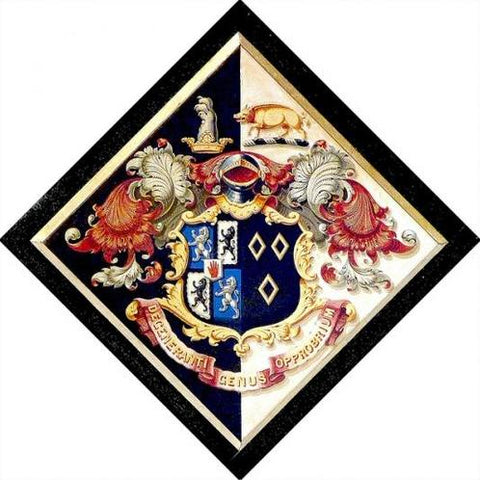Where did Heraldry originate ?

Man has created many different systems of signs for communication and assimilation of information since time immemorial. Humans have made extensive use of these symbols as a means of expression and communication. Today it is difficult to imagine past and present civilizations without ancient hieroglyphics, letters, numbers, road signs, Morse code. Coats of Arms, which first appeared in the Middle Ages and remain in use to this day, also belong in this list. Their difference, compared to other signs, is that they have more than a practical significance. Even today Man uses symbols to express ideas for which words prove inadequate. St. Patrick selected the shamrock to illustrate his sermon on the Holy Trinity.
Perhaps the most intangible concept of all is that of identity. This involves not only the individual but also his relationships with other individuals. Man is a gregarious, yet somewhat anti-social, being; consequently we find, from earliest times, emblems and symbols serving as a means of identification both personal and collective. Coats of Arms symbols made meaningful the pursuits, ideas, ambitions, and even specific events of society. Victor Hugo once wrote, “ To the person who can read heraldry- the coat of arms is algebra; the coat of arms is a language. The entire history of the second half of the Middle Ages is written in heraldry, the same as the history of the first half is written in the symbolism of the Roman Church”
Coats of Arms were so widespread during the late Middle Ages and modern times that heraldry resonates in nearly all spheres of public life: politics, arts, the military, law, and literature. Noblemen displayed coats of arms on shields they carried into battle, as well as on their clothes at their manor estates. Women sewed dresses decorated in them and palace servants wore heraldic liveries. Coats of arms appeared on flags, seals and signets, coins and medals for special occasions. They served as décor on castles and palaces of sovereigns, and churches, town halls, household necessities, carriages, books, and tombstones of the nobility and of townspeople. Writers created odes and epigrams for coats of arms, and often legends about their exceptional origins. Life was such that a coat of arms followed an individual all the way to their final journey.
According to Sir Bernard Burke, the Ulster King of Arms, “The registry of its [heraldry’s] birth may be found among the archives of the Holy Wars … its cradle was rocked by the soldiers of the Cross and its maturity was attained in the chivalrous age of feudalism…” Obviously, the good sir means that one can not separate heraldry from the history of the Middle Ages and perhaps the reverse is also true.
Regardless, one can say with great certainty that between the years of 1135 and 1155 AD certain seals show that there was some sort of adoption of heraldic devices on the European continent. Perhaps it was, as many historians surmise, so that a knight could be recognized on the field of battle. However, others believe that the coat of arms was nothing more than a vain display, a way for a knight to individualize himself and his family, showing pride for who he was and what he had accomplished.











